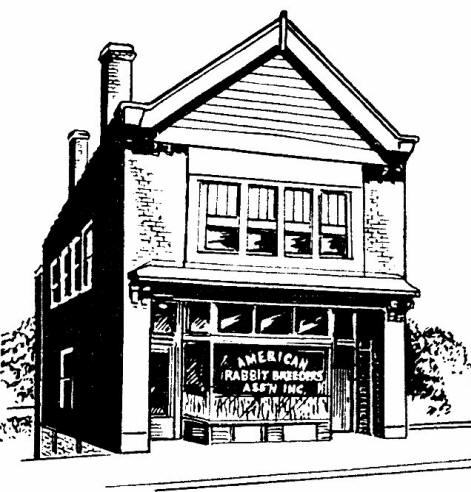
Historical Photos
First Official Headquarters owned by the organization
When the landlord continued to raise the rent on the building used by the American Rabbit and Cavy Breeders Association, Inc. while James Blyth was a fledgling secretary, it was decided to look for better facilities. James Blyth located this former Jewish Synagogue in 1948. The entire Board of Directors came to Pittsburgh, Pennsylvania to view the possible new facilities. The site was approved, and through generous donations from affiliated clubs of the then AR & CBA, Inc. and her many members the building was purchased for $15,500.00. James Blyth and his family lived on the upper level, offices at ground floor, and the basement was used as storage for the associations’ supplies. It became the first official headquarters that the organization owned, at a time when the membership stood at 12,000. The building was sold in 1972 when James Blyth retired after serving 27 years as secretary.
Logos of the Past
First Logo (1910 – 1917)
National Pet Stock Association of America was founded on January 10, 1910 by Charles S. Gibson at his home at 1045 West Warren Ave., Detroit, Michigan with a total of 13 people present who became charter members. Charles Gibson was elected as the Secretary/Treasurer. It is not known who designed the first national emblem, but it was common place for the time to use the head of Lady Liberty with the laurel leaves in her hair along with the crossed flags as part of an American
symbol.
Second Logo (1917-1924)
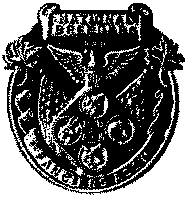 The organization changes their name to the National Breeders and Fanciers Association of America. The emblem you see was created by the George Lauterer Company of Chicago, Illinois. There is once again the crossed US flags, eagle with her stretched wings, double maple leaves (no doubt to recognize our neighbors to the north’s membership), plus the heads of four animals; top is a raccoon, right a cavy (guinea pig), bottom a fox and finally a rabbit. In January, 1918 the first national convention and show is held in Kansas City, Missouri with a total of 540 entries. The organization splits in October, 1919 and Charles Gibson
The organization changes their name to the National Breeders and Fanciers Association of America. The emblem you see was created by the George Lauterer Company of Chicago, Illinois. There is once again the crossed US flags, eagle with her stretched wings, double maple leaves (no doubt to recognize our neighbors to the north’s membership), plus the heads of four animals; top is a raccoon, right a cavy (guinea pig), bottom a fox and finally a rabbit. In January, 1918 the first national convention and show is held in Kansas City, Missouri with a total of 540 entries. The organization splits in October, 1919 and Charles Gibson
incorporates the new branch in January, 1920 as the National Breeders and Fanciers Association, Inc. Gibson is replaced as secretary in 1921 by Raymond L. Pike and the national headquarters is moved to Crawfordsville, Indiana. Pike is replaced by Arthur Weygandt as secretary in 1923 and the national headquarters is moved once again to Weygandt’s home at 3166 Lincoln Ave., Chicago, Illinois, then shortly after to 7408 Normal Ave., Chicago.

Third (1925-1952) and Fourth Logo (1944-1947)
The organization became more specialized with the small stock that they promoted and once again changed their name officially on January 20, 1925 to the American Rabbit and Cavy Breeders Association, Inc. Before this change, the association catered to not only rabbits, cavies, raccoons, and foxes, but most all furred animals including rats, mice and even skunks. Oddly enough the association did not have an official logo until the 1940’s. Arthur Weygandt proved to be an outstanding choice for secretary and served the organization well for 20 years until he was forced to resign in early 1943 due to a stroke, being replaced by Mr. Lewis S. J. Griffin.
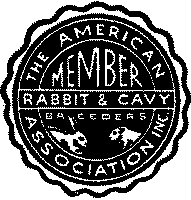 A new logo appeared only in the 1940’s which touted the domestic rabbit for it’s meat, fur and wool, with special emphasis placed on the cavy as an important laboratory animal, which indeed it was. The scalloped border is believed to be designed after a rosette ribbon showing that both species were highly popular as show animals. The war years were hard on the organization, but the meat of the domestic rabbit received a huge boost for its quick growth and high nutritional values by the United States government. Griffin as secretary moved the national offices to his home at 812 East Costella, Colorado Springs, Colorado and then to rental facilities for a short time in 1945 at 25 East Colorado St., Colorado Springs. Due to failing health Griffin resigned in 1945 and James Blyth moved the offices to 5941 Baum Blvd., Pittsburgh, Pennsylvania when chosen as the new secretary. A milestone was reached when affiliated clubs of the national and her membership pitched in together and purchased a permanent headquarters at 4323 Murray Avenue, in Pittsburgh.
A new logo appeared only in the 1940’s which touted the domestic rabbit for it’s meat, fur and wool, with special emphasis placed on the cavy as an important laboratory animal, which indeed it was. The scalloped border is believed to be designed after a rosette ribbon showing that both species were highly popular as show animals. The war years were hard on the organization, but the meat of the domestic rabbit received a huge boost for its quick growth and high nutritional values by the United States government. Griffin as secretary moved the national offices to his home at 812 East Costella, Colorado Springs, Colorado and then to rental facilities for a short time in 1945 at 25 East Colorado St., Colorado Springs. Due to failing health Griffin resigned in 1945 and James Blyth moved the offices to 5941 Baum Blvd., Pittsburgh, Pennsylvania when chosen as the new secretary. A milestone was reached when affiliated clubs of the national and her membership pitched in together and purchased a permanent headquarters at 4323 Murray Avenue, in Pittsburgh.
Not pleased with the design of the previous emblem of the national association a new design appeared in the late 1940’s, however this designer was unknown as with previous designs. The scalloped edges were increased to be more in style with a prize rosette and the emphasis of what the species were mainly used for were removed.
Fifth Logo (1953 – 1992)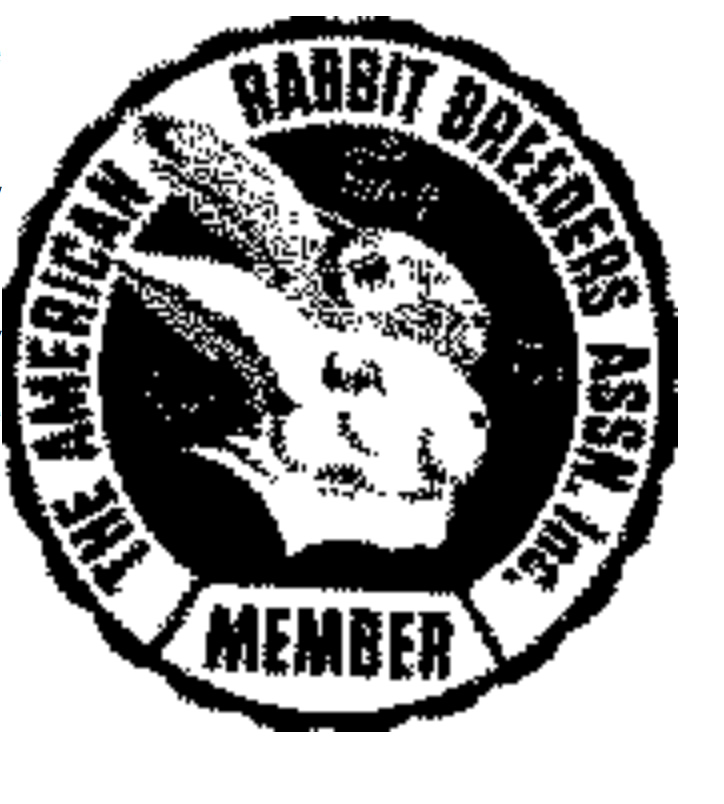
During the 1952 national convention and show the association decided to change the name of the association for the final time to American Rabbit Breeders Association, Inc. It was the consensus that the national mainly existed for the promotion of the domestic rabbit, however cavies would continue to be sponsored by the ARBA. With a brand new name, came a brand new logo and this time we do know the designer, Edward H. Stahl of Missouri. He retained the scallop border, included the words, Food, Fancy and Fur and the heads of two rabbits looking to the right, or as Edward Stahl once said, “Always towards the Future.” The rabbits used in the logo were actually real animals; the top a Standard Chinchilla buck called Chin Champ was Best Standard Chinchilla at the 1924 Lima, Ohio Convention and the bottom rabbit a New Zealand White buck called White Champ that won Best of Breed at the 1932 Pittsburgh, Pennsylvania Convention.
Secretary James Blyth retires in December 1972 after a remarkable service of 27 years in the position under no less than 6 presidents. Ed Peifer, Jr. became secretary from 1973 until December, 1984. He moved the national headquarters to rental facilities at 1006 Morrisey Dr., and then to 2401 E. Oakland Ave. both locations in Bloomington, Illinois. In 1976 the ARBA purchased their own facilities at 1925 South Main in Bloomington. Upon Ed Peifer’s retirement, Glen C. Carr of Ohio was appointed secretary, but instead of moving the national offices he was the first secretary to move to where they were located. Peifer had begun to bring the association into the modern era of the internet age and Glen Carr certainly continued to improve and streamline all office operations.
Sixth Logo (1992 – Present)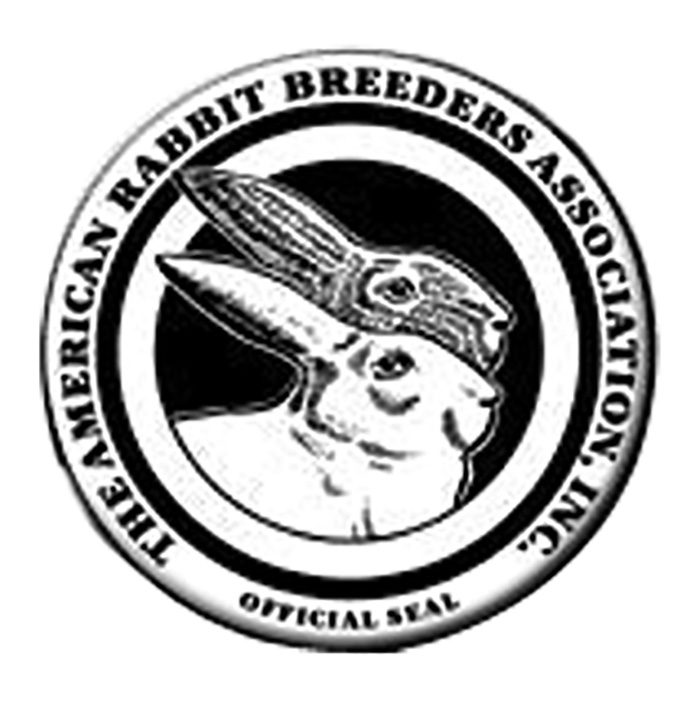
Because of the changing times and the attitude of people, it became very apparent that the words “Food and Fur” was no longer the primary focus of the fancier’s organization. Although the American Rabbit Breeders Association, Inc. recognizes the many valuable benefits of the domestic rabbit; meat, laboratory, fur, wool, fun, pet and fancy (exhibition) the words “Food, Fancy and Fur” were removed from the emblem. Kevin Whaley created the current logo to bring it into the 21st century as the ARBA continues to adapt to a changing country and world from it’s nearly century of existence. With the continued growth of the ARBA it quickly became apparent that a much larger facility was needed. A modern 10,000 square foot facility was located by Secretary Carr at 8 Westport Court in Bloomington which the ARBA purchased. In 1999 construction began for the Hall of Fame Library within the headquarters, which quickly became the world’s largest single collection of rabbit and cavy publications. In 2003 the name of secretary seemed out of place for what the position had evolved into and was renamed Executive Director.
Executive Director Glen C. Carr retired on December 31, 2006 and was succeeded by Executive Director Brad Boyce.
After a brief term as ARBA Executive Director, Brad Boyce was succeeded by Eric Stewart in 2009.
Mr. Stewart, ARBA’s current Executive Director, is committed to steady progress as far as establishing improvements and advances in technologies utilized in the ARBA office. Additional changes to the ARBA’s online presence are planned. This steady evolution will improve existing services while adding new elements contributing to the betterment of the ARBA and its members world-wide.
